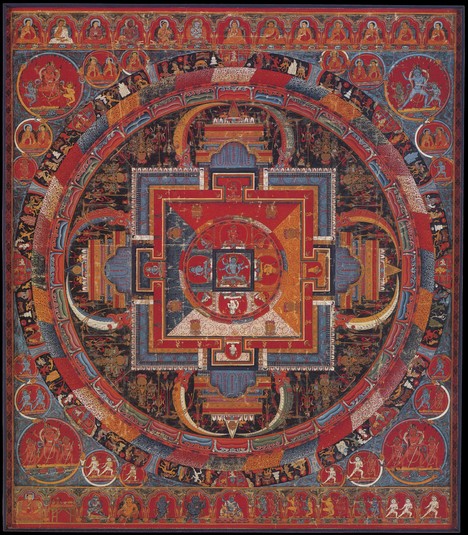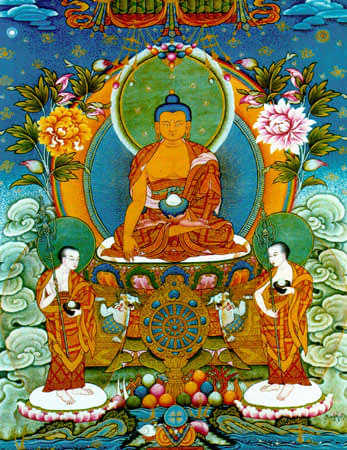Library - Tengyur - Comments on tantras

aṣṭa-śmaśāna-nāma
Eight cemeteries
I prostrate before Hevajra!
According to the sequence, behold the eight protectors of the universe on the eight lands, etc., the eight families of the nagas, the deities of the lords of the lands, the trees, the rain clouds.
First everyone [should see] in the east - the Nagapushpa tree, Attahasa, Indra, the king of the nagas Mahapadma, the rain cloud Ghora and a color like saffron.
In the south, the treeo amra, Charitra, Yama, the naga king Kulika, the rain cloud Chanda. Blue color.
In the west - ashwattha tree, Kolagiri, Varuna, king of the nagas Karkotaka, rain cloud Ghana, white color.
Towards the north, the Punnagara tree, Jayanti, Vaishravana, the king of the nagas Sankhapala, the rain cloud Aparto, yellow color.
In the northeast direction - the nayagrodha tree, Ujjayani, Rudra, the king of the nagas Takshaka, the rain cloud Garjita, black color.
In the southeast direction - karanja tree, Prayaga, Agni, king of the nagas Padma, rain cloud Gharmita, multicolored.
In the southwest direction - the latajata tree, Sama with twisted ears, Rakshasas, king of the nagas Ananta, rain cloud Parkhana, black color.
In the northwest direction, the udumvara tree, the fortress of the goddess, Vayu, the naga king Vasukira, the rain cloud Purana, black and white color. Comprehend according to this sequence of lands.
Translated by the Indian preceptor Ratna Sri Mitra, the monk Shakya Yeshe. Translated by Lama Karma Paljor.
Library - Tengyur - Comments on tantras

aṣṭa-śmaśāna-nāma
Eight cemeteries
I prostrate myself before the glorious Heruka!
O glorious hero, Heruka! Thou art beautiful with joint-born joy! You bestow the special fruit of food and liberation! I prostrate to the lotus feet of the teacher-guru!
The cemetery tree, the protector of direction, the nagas who scatter water [clouds] - abide in the classification of names and directions. I will make a note for memorization.
In directions such as east to the left, etc., and in directions of the northeast to the right - within the vajra tent there are connections of four and four [directions]. The manifest ones are the essence of Gahara, the highest of the fierce ones, and possess a mouthpiece with bubbling flames.
The utterly terrifying indeed are found beginning from the eastern direction and continuing to the left. In the northeast direction is Attahasa. In [the direction of] the southeast is Lakshi. In the direction of the southwest is the terrifying darkness. In the northwest direction, the sounding Kilikila. In the cemeteries within the vajra tent [manifest] the terrifying forms of clusters of the living dead, bhuta, and the terrifying sounds of jackals.
In this sequence of such [manifestations], the eight cemeteries are the place. What are the tree, the protector of direction, the lord of the nagas, the lord of the rain-cloud there? Shirasha, ashwadha, kamkelle, the chuta tree. In the intermediate [directions], as above, karanja, Indra, Vaishravana. From the side of the lords of the nagas [appear] the lord of Yama. From the northeast - lord Agni, lord Rakshas and lord of wind. Vasukira, Taksaka, Karkotaka, Padma, Mahapadma, Huluhulu, Kulika and Shankhapala [also appear in succession].
Garji, Ghurmito, Ghora, Apato, Ghana, Parhana, Purana, and Chanda are the lords of the rain-clouds.
Translated by the Indian preceptor Ratna Sri Mitra and the monk Shakya Yeshe. Translated by Lama Karma Paljor.
Library - Tengyur - Comments on tantras

hevajra-stotra
A hymn of praise to Hevajra
Everything [in your manifestation] is the supreme nature of matter! Initially, all [appear] as the Tathagata! You possess essence as the essence of non-divinity! I extend myself and praise Hevajra!
The blue [face] is the unchanging dharmata! Red is the unbroken stream of compassion! As [the hair] rises upward, you lead beings! I prostrate and praise Heruka!
The three eyes are the three perfect liberations! Since the reds are the essence of strat iyi dharmata! The sound of hūṁ does not appear as born! I prostrate and praise the chief among all!
In the right [hand] is the vajr that destroys poisonous [beings]! In the left [hand] the kapala that preserves bliss! The symbol of wisdom is the rod-khatwanga! I prostrate and praise the sambhogakaya!
Kapala is the matter of the five primordial wisdoms! The five wisdoms are the five families! Garlands and necklaces discard the composite! I prostrate and praise thee, nirmanakaya!
Thy lotus seat is not concealed by obscurations! The corpse of Brahma does not possess thoughts! The sun - burns away ignorance! I prostrate and praise the body that is not concealed [by filth]!
Thus concludes.
Translated by Lama Karma Paljor (O.E. Filippov).
Library - Tengyur - Comments on tantras

sarva-bhūta-bali
Torma of all bhutas
I prostrate before the glorious Hevajra!
I prostrate before Vajrasattva, who is definitely immersed in the e-vam aspect!
Having prostrated, I will perform [the offering of] torma for the sake of protecting living beings from hindrances and false guides.
A yogi who possesses the yoga of Hevajra should perform the following meditation. In the source of phenomena-dharmas, three [levels] of the eight-petaled lotus are arranged. On it successively [appear the syllables] oṁ, āḥ, hūṁ, of white, dark, and red [colors]. Also successively give birth accordingly to the lotus color to the eight great deities, the eight protectors of directions, and the eight great nagas. In the east, beget Maheshvara. In the south, represent Ishvara. In the west, beget Brahma. In the northern direction, [originate] Vishnu. In the southeastern direction, beget Kameshvara. The lord of the southwestern direction is Bhrima. Giriti is in the northwest direction. In the northeast direction is the youthful Kartika.
On the petal [lotus] in the eastern [direction] represent Indra. In the southern direction is the pit. Varuna is on the western petal. Similarly, on the northern one, yaksha is established. In the direction of fire, Maha Agni. In [the direction of] freedom from truthfulness - rakshasas. In the northwestern direction - Vayu. In the northeastern direction, the lord of bhuta. Karkotaka, Shankhapala, Ananta, Vasukira, and similarly Takshaka, Kulika, Mahapadma, and Atyantapadma [the kings of the nagas] appear. All of them with one countenance and two hands in which they hold a vajra and a bell. They are encompassed by the parts [of their bodies] by consorts of their own color. They are seated on a seat with their right leg extended. From the syllable-seed in their own heart, rays of light like an iron hook are emitted. Once emitted, gather in the eight deities of the spheres of form and the spheres of no form. The people and gods of the sphere of desire fully gather in the eight protectors of directions. The three lower divisions and the asuras unite in the eight great nagas. Gauri seizes them for the sake of inviting the mandala that is in the seat of his own nature. When done so, thieves and robbers are bound with rope. With an iron chain the living dead are bound. With a bell [is seized] by Kamadeva, that which is capable of devouring.
Rays of light like iron hooks spread from the heart of a yogin. By them are seized the Victorious ones of the ten directions together with the Sons. Realize to them external, internal and secret offerings. At the completion of the initiation [that is bestowed] by them all, my head is adorned with the lord of the family. In the eight great deities, constancy appears. In the eight protectors of direction is the vajra. In the eight nagas is the lord of dance.
Then realize through ritual the practice of torma. Imagine that in the mandala of wind and fire a lotus vessel arises from the syllable a.
In it [arise]:
bhrūṁ āṁ jrīṁ khaṁ hūṁ go ku da ha na
Imagine that from them in the midst of the Moon and Sun [appear] the five Enlightened Ones, the five kinds of beings.
Visualize in the middle of the Sun the syllable hūṁ. Through the blowing of the vajra and the emission [of rays of light]-the nectar is fully formed.
With meditation on this nature of water, [say:]
oṁ āḥ hūṁ
Thus bestow the blessing.
The mantra for offering such torma is as follows:
oṁ andi jama jala jakkha bhūta bahni vāu rakṣa canda sujja māda pāppa tala pātāle aṣṭa sappa svāhā
These are the guests of the torma:
idaṁ baliṁ bhuñja jiṁgha phulla dhūppa māṁsa pighaṁ
That is getting what is accepted.
aṁbha sappa kajja sāda khānti khuṇi pheḍa gāda
That is dissolution.
oṁ akāro mukhaṁ sarva dharmā ṇāṁ ādya nutpanna tvāta oṁ āḥ hūṁ phaṭ svāhā
That is blessing.
Showing then joy, utter one hundred syllables asking to leave:
oṁ vajra satva samaya manu pālaya vajra satva tvenopa tiṣṭha dṛi ḍho me bhava suto ṣayo me bhava anu rakto me bhava supo ṣayo me bhava sarva siddhi mme praya ccha sarva karma su ca me cittaṁ śre yaḥ kuru hūṁ haha haha hoḥ bhagavān sarva tathāgata vajra mā me muñca vajri bhava mahā samaya satva āḥ hūṁ
Make this torma offering. If the complete offering is realized, all the bhūtas will form good things for the yogin.
At that time, uncontaminated bliss, satisfaction of the deities, and the formation of a good retinue are manifested. If one brings up the torma for this accumulation of bhutas, one will realize subjugation, annihilation, destruction of the enemy class, expulsion, conquest, pacification, formation of happiness and increase.
Thus concludes the torma ritual for bhutas compiled by the teacher-acharya Durjayachandra.
Translated by the Indian preceptor Gayadhara, translated by the monk Shakya Yeshe. Translated by Karma Paljor (Filippov O.E.).
Library - Tengyur - Comments on tantras

stūpa-vidhi-nāma
Stupa ritual
I prostrate before Hevajra!
If a Hevajra yogi makes a stupa for the sake of himself and others, he should first make clay of jewels, fragrant water, etc. on the ground. When you have done so, put it in front of you. When you appear clearly [in visualization] as your own exalted deity, meditate on the four measureless ones.
Then [recite] the mantra of perfect purity, the supreme reality-dharmata:
oṁ svabhāva śuddha sarva dharmā svabhāva śuddho haṁ
Meditate that by doing this the clay becomes invisible. When you do so, visualize Hevajra in union, [manifested] from the three rituals.
Then by rays of light from the syllable hūṁ or hrīḥ in the heart, the boundless Enlightened Ones and bodhisattvas are grasped and dissolved in light in the abiding father and mother of Hevajra. From what has appeared as the enlightened mind-set, [arises] blessing through the twenty-one Hevajra hearts:
oṁ deva picu vajra hūṁ hūṁ hūṁ phaṭ svāhā
Or:
oṁ āḥ hrī hūṁ
And mark with this mantra [with the breath].
When you also visualize each of the stupas as Hevajra, then do also for each of them the emanation of many Hevajras and the gathering. Visualize that on the basis of this the goals of yourself and others become complete.
Then perform the blessing with the heart of interdependence and realize the completion [of the prayers of benediction].
This is how the stupa ritual composed by the great acharya Krishnapada is completed.
It was heard from the great grammar expert Jin Karnapada. Shakya monk and translator Nyima Gyaltshen Pal Zangpo translated in the great temple of Pal Tharpa Ling.
Translated by Karma Padjor (O.E. Filippov).


